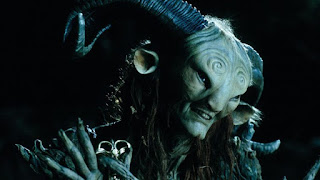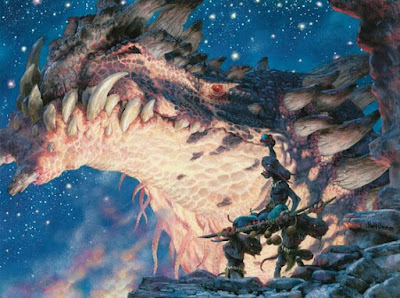The Feasting Hall
I am currently working on a megadungeon inspired by the works of Guillermo Del Torro, Darkest Dungeon, and Bloodbourne called Shadows Under Vargenhelm. In order to spice up individual runs, I created a Happenings and Occurrences table to roll on every time a party decides to delve into the Dark Below. This includes other rival adventuring parties that have made their way into the player's part of the dungeon, Slugmen Salesmen, and a wandering Fae Feasting Hall that will sometimes show up in empty rooms.
This last inclusion is what I wanted to share with you today because I think it could be slotted into a great deal many adventures and contains some of the thematic elements that I hope Shadows will be full of!
This last inclusion is what I wanted to share with you today because I think it could be slotted into a great deal many adventures and contains some of the thematic elements that I hope Shadows will be full of!
The Fae Feasting Hall
There is a magical hall that leaps from place to place. A grand table, the magical artifact which allows the Hall to change positions, is made of living wood and takes up the center of the room. Roots emerge from its legs, growing into trees that climb the walls and obscure the ceiling. Strange light glitters through from above through the gold and silver leaves of the trees: a weird light from faerie land. Seated around the table is a collection of fae creatures that are constantly engaged in one kind of game or another. Each time the Hall is found, a new creature is designated and Lord/Lady of the Hall and everyone obeys them, changing the nature of the interactions to be had within each time the party stumbles across it.
Roll 1d6 to determine who is the Lord/Lady this time.
1: The Lady of Moths: This tall woman with long sliver hair that flows down to the ground is constantly covered in moths. The moths occasionally take flight and land on her again, but her face is never revealed beneath their constantly gently moving wings. She is a melancholy spirit, directing the Hall in the reenactment of ancient tragedies.
If the PCs attempt to join in an ongoing performance, they will find that these creatures have no concern about life, themselves not being terribly fragile. They do not use prop swords. If the play is disrupted, however, she will be very angry. The offending party member will find themselves teleported by a great column of moths to a random place within the dungeon with many holes in their garbs.
If the PCs should successfully put on a performance with or without the Fae, she will daintily clap her hands and give each PC a white lily from her hair. With this white lily, the PCs gain 2d4 Temporary Hit Points. If these are used up, the flower wilts, releasing the stench of decay and giving all who smell it a brief premonition of their own deaths.
2: The Laughing Satyr: This boisterous fae always packs the table with the most delicious of meats! A band of satyr musicians play dancing tunes for him and occasionally his personal bard will sing a bawdy tune. His skin is scoured with curling markings and his hands are on backward. A scar covers one of his eyes and the eye itself is replaced by a sphere of pure lapis lazuli.
The Laughing Satyr likes to play Simon Says. Each time he says “Satyr Says…” all the fae immediately obey. This often means switching from dancing to eating to singing to dancing to laughing at his jokes to eating and so on. The PCS should do something without being told to with “Satyr Says,” he will direct his lapis lazuli eye at the offending PC and turn them into a monkey. He will then immediately say “Satyr Says catch the monkey! Whoever catches it, keeps it!” This is his favorite game. Whoever catches the monkey gets to keep it, so the party ought to be sure to catch it.
If the PCs should play for an entire 1d4 Turns, the Satyr will tell them to approach. He will give them his eye which will allow them to command a foe that looks into it with “Satyr Says!” and they will have to do what you say no matter how ridiculous or harmful to themselves. After this item is used, it disappears.
3: The Lady of Many Faces. When she isn’t Lady of the Hall this fae bundles herself up in black silk and wears a red mask with emotionless expression. When she is the Lady, she is a great black spider atop the living tree throne with six long snake-like necks ending in faces that she has stolen. If any show emotion in her presence, she immediately takes their face, adding it to her collection. All of the fae are completely emotionless when the party enters, and the table is covered in bloody human remains.
Another PC may regain the face of the faceless PC by beating the Lady in a game of riddles. If the PC should win such a game or if the party should stay completely emotionless for 1 Turn, the Lady will give them her mask. Placing this mask on a person’s face will remove their face, turning the mask into an exact copy. Anyone that wears this mask, after that, will transform into the exact likeness of the victim.
4: The Thin Lord and His Child: The thin, pale, disfigured man wears sagging royal robes over sagging skin that no longer seems to fit him. Growing from his lower torso is a living tumor that looks like a child. Whatever the Thin Lord says, it says the opposite. He feeds it from one of his sagging breasts. This is the only time it does not speak.
The Thin Lord demands poetry. All the Fae will line up to say a few lines whimsically rhyming poetry. The best poem wins. If a PC wins the contest, he will give them a small porcelain miniature of a baby. If anyone swallows this miniature, a child-tumor will grow on them that will speak the truth whenever they lie.
If anyone should lie in the Thin Lord’s presence, the Child will let out a low groan that becomes louder and louder until a child-tumor sprouts into being on the liar. It will speak the truth whenever they lie.
5: The Fat Lady: This rotund, olive-skinned woman is covered in jingling gold bells. She constantly bears a hand mirror that she uses to admire herself. The men of the hall will throw themselves at her, asking for her love and brawling with each other over the opportunity while the women of the hall constantly give her praise for her beauty.
The table is covered in deserts of all kinds, and gnomes wearing golden smiling masks constantly bring her more desert. If a PC can bring her a suitably impressive gift and say suitably impressive words, she will give them a kiss and give them her mirror. The mirror causes anyone who kisses it to be jealously loved and admired by everyone around them for 1 turn. After this item is used, it vanishes.
If a PC should tell the truth or say anything negative about her corpulence, then she will flash her mirror at them, making the offending PC massively obese.
6: The Headless Lord: This Lord is dressed in practical riding wear and always brandishes a sword in one hand while holding the hair of a beautiful woman’s head in the other. A masculine voice comes out of the head’s mouth, speaking for the Lord.
The table will be covered in pumpkins that will be thrown off by the constant dueling which happens upon it, though it will seem there will always be pumpkins to replace them. He will challenge the PC that looks most like a warrior to a duel. If the PC should turn down the duel or attempt to cheat, the Lord will chop off the PC’s head in an instant and replace it with a pumpkin. The PC’s head will now be the one out of which the Lord talks.
If the PC should take the challenge and win, the Lord will give them his sword. This sword can be used, once per day, to challenge anyone to a duel to the death and they must accept. The sword is a +1 Rapier (1d8+1).
If the PC should lose, the Lord spares them and salutes them for a good duel.
Headless Lord: +4 Dueling Rapier (1d8+1), HP: 20, AC: 14, HD: 3d10, Saves: +4. SP: Head Crack (As a Reaction, when an opponent misses an attack against this enemy, they must make a DC: 15 Ref Save or take 1d4 damage from the Lord swinging his head around)



Very nice! I really like procedural storytelling, and this piece has a distinctive macabre tone that's sure to shine through no matter how events play out. I'd love to play in this campaign!
ReplyDelete